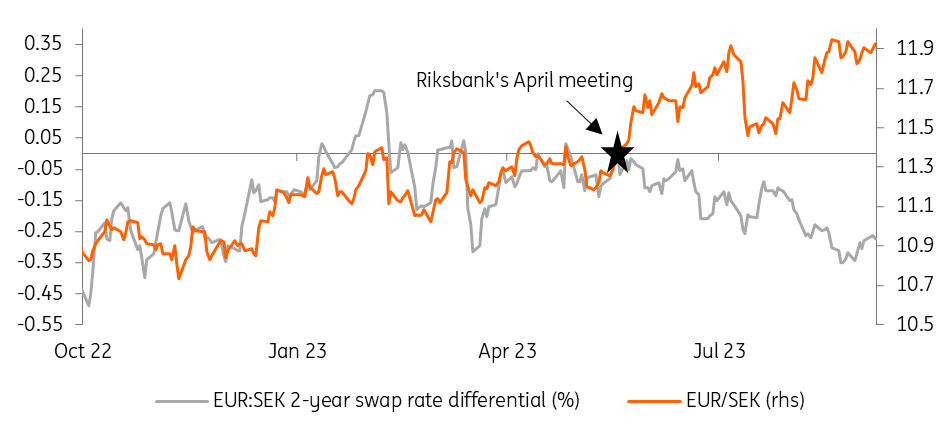Swedish krona still searching for the bottom, but the Riksbank can help
EUR/SEK is close to the 12.00 level, trading at historic highs as external and domestic factors have added pressure to the already weak krona. In the medium term, we have few doubts SEK can recover and converge with higher fair value, but the timing is highly uncertain, and will be more dependent on the global market environment than on Sweden’s economic woes
Why it’s still hard to pick the bottom for the krona
Back in May, we published a note entitled “Sweden: Hard to pick a bottom for the unloved krona”. More than three months later, it is still hard to pinpoint an end to the EUR/SEK rally, and the key drivers behind the strength in the pair have not changed materially. Back then, the Riksbank had just lifted the cap on the pair with a dovish surprise, and while it later attempted to restore a currency-supportive hawkish stance, markets have continued to price a good deal of domestic downside risk into SEK.
In the broader FX picture, pro-cyclical currencies like SEK are primarily responding to US data at the current juncture: the recent resilience in activity indicators has kept market expectations for Fed easing capped, global rates elevated, the dollar strong and high-beta currencies under pressure.
Remember how NOK and SEK emerged as the two biggest underperformers during the core of the Fed tightening cycle? As the higher-for-longer narrative in the US consolidates, investors are once again turning their backs on the illiquid Scandinavian currencies. And with Sweden facing domestic headwinds and the eurozone’s economic outlook deteriorating, EUR/SEK is trading at fresh highs, and at risk of touching the 12.00 pain level.
SEK slump continues

The Riksbank can cap krona weakness
The chart below shows the risk premium (orange line) that has been built in for the krona (against the euro) since the start of the year. That tells us how much higher EUR/SEK is trading compared to what we estimate is its fair value according to market drivers (like rates and equities).
Riksbank has had a big impact on SEK misvaluation

Despite perceived real estate concerns building steadily into the end of April, EUR/SEK traded close to its fair value thanks to the Riksbank’s currency-supportive hawkish tone. The shift in narrative at the April meeting (when two members voted against a 50bp hike, and the rate path was more dovish than expected) led to a spike in SEK undervaluation, which lasted for two months. Crucially, the return of a currency-supportive hawkish stance at the Riksbank’s June meeting saw the EUR/SEK mis-valuation drop to zero. The following build-up in the EUR/SEK risk premium was much more short-lived compared to the one in May-June, and primarily a consequence of the bond sell-off in the US.
The Riksbank can still impact the krona substantially
So, what is this telling us? The Riksbank can still impact the krona substantially. Despite not being able to fully insulate a high-beta currency like SEK from external drivers, it can prevent it from trading below its short-term fair value. To do this, it must meet or exceed market expectations on future rate tightening (i.e. via rate path projections), which has the additional benefit of signalling that the Bank is not so worried about the economic outlook and the risks to financial stability as to overlook its inflation mandate and the need to stabilise the currency.
Markets are fully pricing in a 25bp hike in September, with a 50% implied probability of another 25bp hike at the November meeting. The Riksbank will likely have to signal one more hike in its rate path projections to support the krona when it raises rates in September.
Our SEK forecast: the question is timing, not direction
One aspect of the lingering SEK risk premium is that it has detached from short-term rate dynamics, which had been a key driver until April/May last year. Based on the EUR:SEK two-year swap spread alone, EUR/SEK should be trading around 11.00 (chart below). In the current market conditions that is, obviously, inconceivable.
EUR/SEK has diverged from short-term rate dynamics

We continue to base our medium-term forecast on the evidence that the krona is significantly undervalued, both against the euro and the dollar. On the back of this, our forecast profile for EUR/SEK is downward-sloping for 2024, and we expect the pair to trade below 11.00 by next summer.
The timing of the SEK recovery remains quite uncertain
We must admit, however, that the timing of the SEK recovery remains quite uncertain. In our view, this is not excessively dependent on domestic factors; the krona is already pricing in a sizeable amount of weakness in the domestic economy, and markets will either see the most dramatic scenarios for the real estate sector materialise (not our base case) or will have to price them out of the krona next year. Missteps by the Riksbank, if anything, have a higher chance of causing FX damage.
External drivers hold the key to the recovery
We think, instead, that SEK’s reconnection with its stronger fundamentals will be driven by the global FX narrative. A strong dollar on the back of higher-for-longer rates in the US is incompatible with a recovery in the krona. The past few months have been a clear testament to this.
We expect US activity data to start turning from 4Q23, and the Federal Reserve to start cutting from March 2024, and that is the window when pro-cyclical currencies like SEK can stage a good rebound. However, we admit that the resilience in US economic data could persist for longer than we estimate, and delay as well as reduce the scope of the recovery in pro-cyclical currencies. A further deterioration in the eurozone growth outlook can also make the krona’s recovery harder.
Until a US data/dollar turn occurs, the krona will remain vulnerable
Until a US data/dollar turn occurs, the krona will remain vulnerable, and we only see 12.00 as the really strong resistance level for EUR/SEK. So far, the Riksbank has ruled out FX intervention but might start throwing that idea around to gauge market reaction (the effective applicability remains doubtful) should we break above the 12.00 mark.
We see room for a SEK rebound around the Riksbank’s upcoming meeting when we expect the SEK-supportive narrative to prevail and a good chance of another hike to be added to the rate path. EUR/SEK could be easing back to 11.70 by the end of September.
This publication has been prepared by ING solely for information purposes irrespective of a particular user's means, financial situation or investment objectives. The information does not constitute investment recommendation, and nor is it investment, legal or tax advice or an offer or solicitation to purchase or sell any financial instrument. Read more
Download
Download article
7 September 2023
Swedish economic and FX update: Pessimism reality check This bundle contains 2 Articles